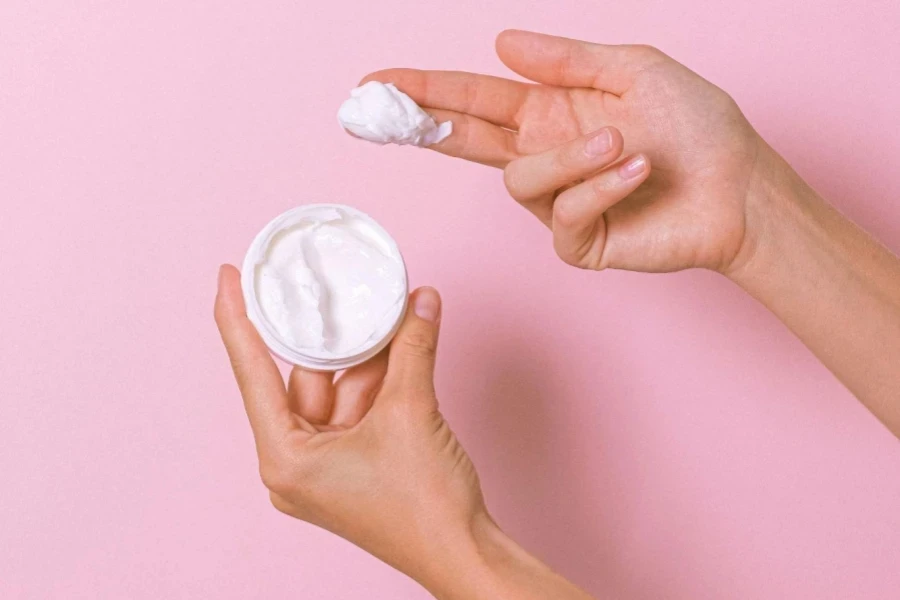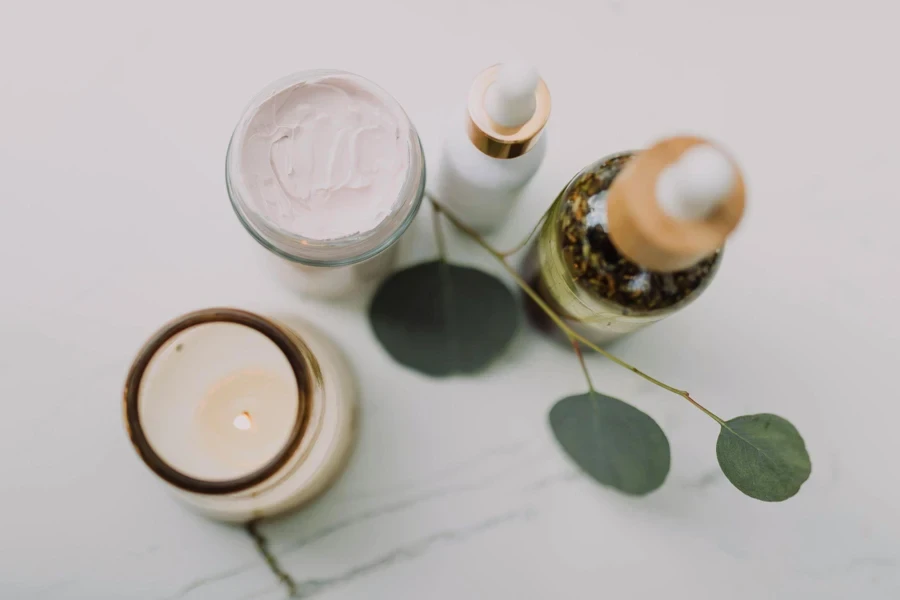Table of Contents
● Introduction
● Key types and uses of face creams and lotions
● Industry overview: 2025 face cream and lotion market
● Essential factors when selecting face creams and lotions
● Top recommended face cream and lotion products and their highlights
● Conclusion
Introduction
These items meet various needs, like improving skin flexibility and controlling oil production. They have updated formulas tailored to distinct skin types and preferences and feature advanced components such as peptides, ceramides, and probiotics to promote overall skin well-being. In 2025, choosing the appropriate facial cream or moisturizer requires comprehension of these specialized formulas to guarantee optimal skin condition, durability, and enduring satisfaction, making them indispensable in any skincare routine.
Key types and uses of face creams and lotions

Hydrating creams
Hydrating creams supply and retain moisture within the skin, addressing common issues like dryness and dehydration. These products often contain humectants, such as hyaluronic acid and glycerin, which help draw moisture to the skin’s surface and keep it there. These products are especially useful for dry skin and are often applied as a foundational step in multi-step skincare routines.
In dry climates, sophisticated moisturizing products incorporate softening agents and barriers to lock in moisture and form a shield. This extra hydration helps maintain a supple appearance for the skin, reducing dry patches and discomfort related to lack of moisture.
Anti-aging formulations
Anti-wrinkle facial creams enhance skin flexibility and diminish signs of aging like lines and wrinkles. Peptides are frequently included to boost collagen synthesis for a skin texture. Bakuchiol is an alternative to retinol and provides many advantages while being gentler, without the irritations associated with retinol products.
These beauty products frequently contain antioxidants such as vitamins C and E that help combat the effects of stressors and enhance a vibrant and youthful look. Anti-aging creams cater to both immediate needs and long-term care, providing visible improvements while supporting overall skin resilience.
Barrier-repair moisturizers
Specialized moisturizers called barrier repair creams are designed to enhance the skin’s defense system by blocking moisture loss and safeguarding against irritants like environmental factors such as dirt and pollution particles. These creams contain components such as ceramides and fatty acids that effectively repair the skin’s lipid composition, which makes them a great choice for individuals with damaged skin conditions.
These creams are commonly suggested for individuals with eczema or rosacea due to their calming ingredients that alleviate redness and irritation. They emphasize improving skin barrier health to provide lasting moisture and support a resilient skin environment.
Oil-control and balancing lotions
Oil-control lotions help regulate sebum production and provide an option for people with acne-prone skin types. The typical components contain niacinamide that helps manage oil levels and soothe the skin to maintain moisture without causing blockages.
These lotions typically avoid heavy occlusive agents, effectively managing shine and preventing breakouts. Added elements like zinc and witch hazel provide additional anti-inflammatory and antibacterial support, promoting a clearer complexion and smoother texture.
Industry overview: 2025 face cream and lotion market

Rising demand for personalized skincare
The skincare industry in 2025 is witnessing a surge in demand for personalized routines, a trend fueled by technological advancements that bring customized care to a wider audience. Experts currently value the global skincare market at USD 109.71 billion as of 2023, with projections indicating it will grow to USD 194.05 billion by 2032. This increase is expected to occur at a compound annual growth rate (CAGR) of 6.68% from 2024 to 2032, according to Fortune Business Insights. AI tools now assess unique skin characteristics. This technology enhances user satisfaction, as products can adapt based on changing environmental or lifestyle factors, ensuring a consistent and tailored approach.
These solutions are especially relevant in markets that value inclusivity, as brands develop products to serve diverse skin types and concerns. The trend toward personalization has reshaped expectations in skincare, setting a new standard for innovation and individual-focused solutions.
Growth in sustainability-focused products
The skincare industry has now embraced sustainability as a focus area more than ever. Consumers are drawn to brands that prioritize eco-friendly practices, like using waterless products that need fewer preservatives and are better for the planet by reducing waste and conserving water resources.
Moreover, sustainable packaging has become more prevalent as companies use refillable materials to decrease waste. In cosmetics products, sourcing ingredients ethically is also important, with customers desiring transparency in how products are made. As companies incorporate sustainability into their brands, this movement highlights a shared move towards environmental accountability in the skincare industry.
Emphasis on skin health and microbiome support
Skincare trends are changing to emphasize the importance of skin wellness and supporting the skin’s balance rather than focusing solely on appearance in today’s market. Products that promote a microbiome-friendly formulation by including probiotics and prebiotics are becoming more popular because they keep the skin in harmony and minimize problems such as redness and sensitivity.
In addition to promoting a microbiome in the skin’s ecosystem, numerous companies focus on using ions that protect against pollutants and UV radiation damage to encourage lasting skin health. The rising popularity of products that support the microbiome and focus heavily on health underlines the growing significance of science-supported skincare, establishing a benchmark for effectiveness and overall skin well-being.
Essential factors when selecting face creams and lotions

Skin type and specific needs
Selecting a suitable face cream or lotion starts with identifying specific skin types and objectives. Products cater to oily, dry, sensitive, or combination skin, each with its targeted benefits. For example, oily skin often benefits from lightweight, oil-controlling lotions, while dry skin typically requires rich, hydrating creams to improve moisture retention.
Beyond type, individual skin needs, such as hydration, anti-aging, or barrier repair, further shape product suitability. Sensitive skin may call for gentle, fragrance-free options, while aging skin might benefit from peptide-rich formulations. By aligning choices with skin types and goals, these products are more likely to deliver effective, lasting results.
Ingredient transparency and efficacy
Ingredient transparency and proven efficacy are increasingly important for today’s skincare buyers. Leading brands respond by openly sharing information on sourcing, production, and safety data, helping users make informed decisions. Choosing products from companies that prioritize transparency provides clarity on what each formula delivers, avoiding concerns over hidden or harmful additives.
Formulations backed by clinical studies or dermatologist endorsements have also gained traction. Products combining transparency with verified results meet a growing preference for quality and dependability, setting a new standard in the skincare market.
Environmental impact and sustainability
Consumers who care about the environment choose face creams and lotions based on sustainability factors, like packaging. Buyers are leaning towards sustainable ingredients from brands with eco-friendly practices in mind. Waterless skincare trends are becoming popular as they help conserve water and reduce the need for preservatives in beauty products – a feature that resonates well with environmentally-aware individuals.
Eco-friendly skincare products help minimize waste and promote the sourcing of ingredients to appeal to consumers who prioritize sustainability and eco-friendliness in their beauty choices.
Technological advancements and convenience
Technological innovation has transformed skincare selection, with smart devices offering personalized care insights. At-home diagnostic tools assess skin factors like hydration and elasticity, providing tailored product recommendations. These advancements enhance the skincare routine by simplifying management and improving product effectiveness.
Popular at-home treatments, including LED light therapy and microcurrent devices, deliver professional-level benefits with convenience. By incorporating smart tools, consumers are better equipped to choose products suited to specific needs, adding precision and ease to skincare regimens.
Top recommended face cream and lotion products and their highlights

Best for hydration and barrier support
Hydrating creams with barrier-repair properties deliver long-lasting moisture while reinforcing the skin’s defense layer. Ceramides and peptides in these products work to restore essential lipids and support skin elasticity. Many formulas also include humectants like glycerin, which draw in moisture, making these creams ideal for combating dryness and sensitivity in varying climates.
Leading anti-aging options
Anti-aging creams with retinol alternatives, such as bakuchiol, promote gentle cell turnover and minimize fine lines. Epidermal Growth Factor (EGF) is another popular ingredient, supporting collagen production to maintain firm skin. Products that blend these elements with antioxidants, like vitamins C and E, offer additional protection against environmental stressors, promoting a youthful, smooth appearance over time.
Notable selections for oil control
Oil-control lotions and lightweight, water-based creams balance sebum production without clogging pores. Niacinamide is a common ingredient for reducing oiliness and inflammation, providing a matte finish ideal for oily or acne-prone skin. Additions like witch hazel or zinc further enhance these products’ ability to keep skin clear and refreshed throughout the day.
Effective all-in-one creams for minimalist routines
All-in-one creams combine multiple benefits—moisture, SPF protection, and antioxidants—into one product, streamlining skincare routines. These multi-functional creams are ideal for those seeking effective care without multiple steps, protecting skin from UV rays while addressing hydration and environmental stress.
This concise guide covers top face cream and lotion options across key categories, catering to different skin needs with tailored benefits.
Conclusion

Selecting face creams and lotions that align with specific skin needs, backed by current market trends, and supported by high-performing formulations enhances both skin health and user satisfaction. Each choice contributes to a more personalized and effective skincare approach, ranging from hydrating and anti-aging solutions to sustainable and technology-driven products. As the skincare industry in 2025 prioritizes transparency, science-backed ingredients, and environmental responsibility, informed product selection can greatly impact skin resilience and wellness, providing an elevated experience that meets the evolving expectations for quality and care.




